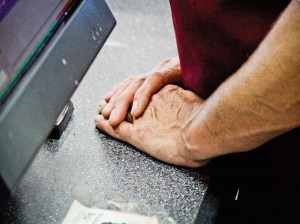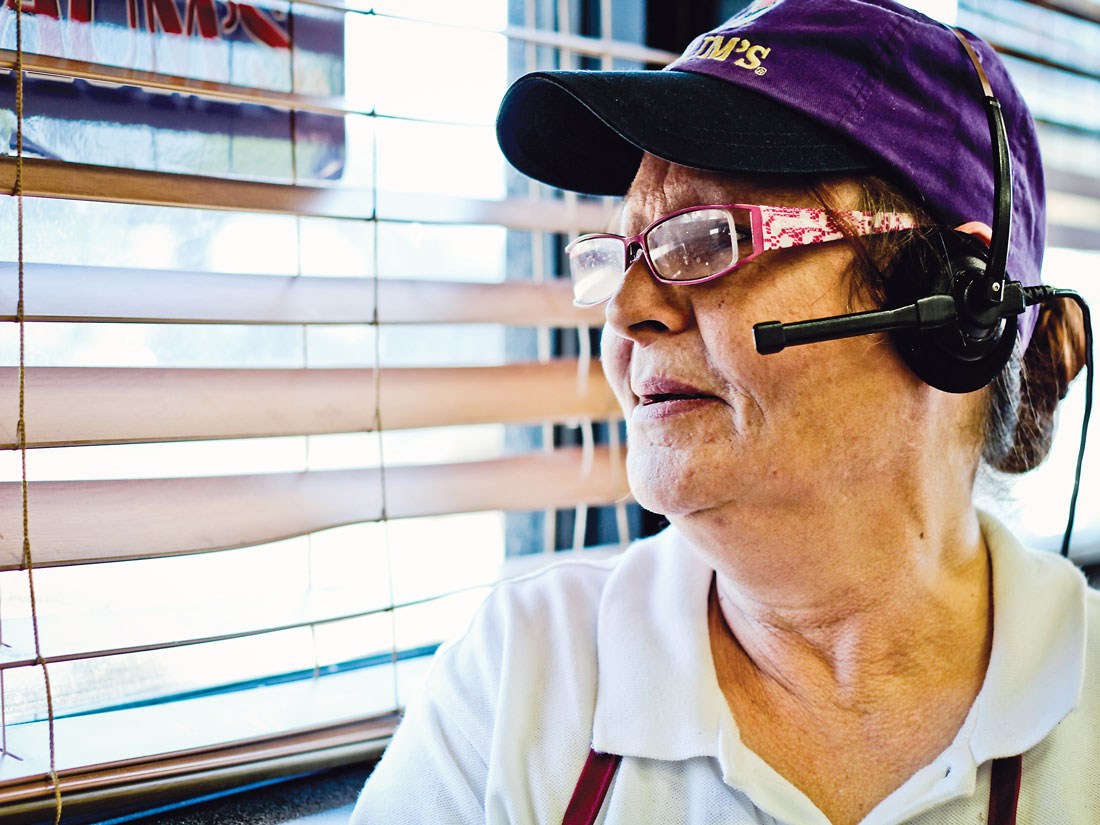Her eyes are aquamarine, piercing but kind. Like the color of the sea before it washes up onto the beach. Those eyes have seen homelessness, heartache, and the daily needs of three little people who call her Mommy.
She wishes her toes were squishing the cool white sand like they did so many times before she left Pensacola, Fla.
Michelle Schmelzle relocated to Texas with her children and boyfriend last March, not knowing a soul in the state. When her boyfriend left her shortly after the move, she knew she had to “do it alone.”
Schmelzle spent six months at Presbyterian Night Shelter near downtown with her kids before she was able to get a job waiting tables at Denny’s.
Today, we’re sitting at a booth inside the restaurant after her shift (8 a.m. to 3 p.m. five days a week). She got off early, and the restaurant is almost empty. I ask for a glass of tea and immediately feel guilty. She’s worked hard enough already.
Schmelzle, 32, makes about $950 a month. That’s with tips and the $2.13 hourly wage for tipped employees. The tipped employee wage, according to federal law, must equal at least $7.25 an hour when tips and $2.13 are combined.
But that income isn’t nearly enough to pay for her unsubsidized apartment or for licensed childcare for her 4-year-old son. Luckily, her other two children, ages 13 and 8, are already in school.
She couldn’t qualify for the county’s childcare assistance program, Child Care Management Services, until she got a job. But she couldn’t work until she had someone to watch her kids. And even with her Denny’s position, she will never make enough to be self-sufficient. It’s the kind of vicious cycle that keeps minimum-wage workers perpetually on the financial edge.
******
Low-wage workers across the country — particularly women — face these problems every day. But in Texas, there’s no end in sight.
Recent attempts to raise the federal minimum wage have gone nowhere. So during the past couple of years, 29 states, including the District of Columbia, have taken matters into their own hands, raising minimum wages above $7.25.
Two weeks ago, the fast food labor campaign Fight for $15 gathered protesters in nearly 200 cities across the country, including Dallas and Houston but not Fort Worth. The protestors are working to raise the minimum wage to what they believe is a livable standard. The Fight for $15 movement gained momentum last year around the time federal legislation failed to increase the minimum wage to $10.10 an hour. Fight for $15 is certainly ambitious, considering $10.10 can’t even get passed in Congress.
David Cooper, an analyst with the Economic Policy Institute in Washington, D.C., told me about 60 percent of U.S. workers are now covered by state wage increases. Cities also have set their own standards. The most notable is probably Seattle, whose city council voted to raise the minimum wage to a phased-in $15 an hour. But for cities like Fort Worth, raising wages is a pipedream. The 2003 state law known as wage suppression restricts Texas cities and counties from raising their minimum wage above federal or state limits. Nineteen other states enforce a similar law.
Without social services in Tarrant County, Schmelzle and her children would still be living at Presbyterian Night Shelter. And without the shelter, her family might have had to sleep on the streets. She was too ashamed to go back home to her family in Florida. And she didn’t have a car to go anywhere else.
With a job in hand, Schmelzle was able to qualify for the housing program at Cornerstone Assistance Network, a faith-based nonprofit in North Richland Hills that serves families struggling with poverty.
Now, she has her own all-bills-paid apartment in southwest Fort Worth and pays just $191 of the $745 monthly rent. When the weather is good, her kids play outside. She doesn’t want them to watch too much television. And she’s working on breaking some bad habits they picked up at the shelter, like talking back and misbehaving.
“I’m glad I’m getting back on track,” Schmelzle said. “It’s a little hard because it’s just me, but I feel like everything is moving forward.”
******
Texas relies on more low-wage jobs (positions that pay less than $10.10 an hour) than most other states, according to the Center for Public Policy Priorities, a nonpartisan research institute in Austin. Of all jobs in the state, almost a third (about 3.2 million) pay their employees less than $11.42 an hour, according to the Dallas Federal Reserve. By one important standard — the percentage of residents living below the poverty line — Texas is one of the poorest states in the country.
Yet Texas produced 2 million of the 5 million jobs created nationwide from 2000 to 2013, according to the CPPP (a fact that Rick Perry likes to flaunt).
That’s because 44 percent of the new jobs pay less than $14.87 an hour — jobs like office and administrative work, food preparation and serving, and transportation occupations, according to the Bureau of Labor Statistics. For even a small family, that $14.87 an hour still might not be enough. Raising the minimum wage to $10.10 an hour would positively affect the pocketbooks — and lives — of nearly 2.8 million Texans, according to the EPI. That’s a quarter of the state’s population.
And it would mean people like Schmelzle would be able to buy new tennis shoes for their kids when they rub holes in the soles. Right now, she said, “They just don’t get it. I just can’t buy it.”
There’s a misconception out there about low-wage workers. People believe these folks are college kids or people entering the workforce for the first time, said the EPI’s Cooper. “But that’s not the case,” he said. “These people are older, supporting a family.”

People like 55-year-old Marion Patton.
I’ve come to Braum’s off University Drive in Fort Worth to watch her work. I order a mint chocolate chip ice cream cone and happily let the aroma of french fries and hamburger grease soak into my clothes.
Patton plunges her arm into a cavernous cradle of vanilla ice cream and fills a waffle cone with two generous scoops. Her red hair is pulled up into a neat bun, and a burgundy apron protects her white short-sleeve polo from the drips and drizzles of ice cream, hot fudge, and grease that invariably splatter on employees behind the counter. She hands the cone to the customer in front of her and gets ready for her next order, a milkshake.
“Small, medium, or large?” she asks the customer. She dips into the frozen tundra of ice cream and fills the cup. In a flash, she’s off to another task, refilling lids at the drink station –– while softly singing and shaking her hips to “We Are the Champions” playing on the restaurant’s radio.
Patton is in the middle of her shift at the burger and ice cream joint where she earns $9 an hour. She beams, telling me that she recently got a raise. When she started two years ago, she was making $8.25.
That means she brings home about $800 a month. She works five days a week, but her shifts are only five and a half hours. She has been told she will go full-time soon, but it hasn’t happened yet.
Patton ran away from home at 14 to escape an abusive stepfather. “I didn’t even finish the 8th grade,” she said. But that didn’t matter then. She just needed to get away. Her first job was at a Jack in the Box. But she said she and a coworker stole some money. “So we quit,” she said.
A few years later, she married the first guy she met. She was 16. He was 35. He “put me out,” she said, meaning he forced her to work as a prostitute. After he went to jail for armed robbery, she went back home and lived with her mom.
“That’s when I started doing meth,” she said.
She lived with a man she loved and had a baby named Nick, but the drugs followed wherever she went.
Her eyes shine when she tells me she’s been clean for four years.
She loves her job but wants full-time work and more money. Her biggest hurdle is transportation. Even though she lives in a rent-subsidized apartment just 15 minutes away by car, getting to and from work takes nearly two hours each way –– she has to take three different buses. And she doesn’t make enough to buy a car or make a car payment.
Financially, times haven’t always been so tough for workers like Patton.
Let’s travel back to the 1960s. Free love. Rock ’n’ roll. And the highest minimum wage the country had ever seen. Adjusted for inflation, the 1968 minimum wage would be equivalent to $10 an hour today. The rate had been keeping pace with worker productivity since the end of World War II, and it stayed that way until the late 1970s. And then something happened. Worker productivity continued to rise, but the minimum wage didn’t. Inflation went through the roof during the ’70s, and the minimum wage didn’t budge a cent between 1981 and 1990. Since 1990, the minimum wage has gone up a few times in phased increases, but it’s never gone up enough to offset the flat wages of the 1980s. Today, the minimum wage is still playing catch-up, but Congress isn’t helping workers.
Cooper blames stagnant wages for a lot of the country’s economic problems.
“In 2015, there’s no reason why a worker should be getting paid less than in 1968,” he said.
The fear of — and argument against –– raising the minimum wage is that it will hurt businesses, especially small ones, and result in higher unemployment.
The effect of the minimum wage on jobs is the most analyzed topic in the debate, Cooper said. The most famous study compared two similar fast food restaurants: One was located on the border of New Jersey and Pennsylvania, and the other was in Pennsylvania. New Jersey raised its minimum wage, and Pennsylvania didn’t. Researchers found that the employment rate at the New Jersey restaurant went up.
Researchers have studied the effects of every wage increase in American history. “The best research we have shows that a modest increase in the minimum wage has no negative effect on employment,” Cooper said.
A modest increase equates to raising the minimum wage by 10 percent. Cooper said that for fast food restaurants like McDonald’s, that raise would translate into making items on the dollar menu cost $1.03.
For small businesses, a wage increase might sound even scarier. But Cooper has a good argument. “No business is facing that cost in isolation,” he said. “If [every business] is facing that same cost, then [no single business] is worse off.”
******













It’s tough out there these days and I feel like a lot of older people who grew up when things were different can not see it so they remain stuck in conservative ideologies that just don’t work anymore. Every time I hear someone may a claim that in America if you work hard, you can be or have whatever you want., I want to scream! It is just not true anymore. Great piece!
No political ideology works anymore. The cost of big government programs is ultimately passed on to the consumers and citizens, no matter what, vastly escalating the cost of living –which is the real problem here. The cost of a higher education is also out of control thanks to predominately liberal universities being able to screw college students and their parents any way they want. Politicians go to Washington and get systemically bribed by lobbyists to vote for more big industry breaks and bail outs at the expense of the average person. It is discouraging.
Thank you, Sarah Angle, for shedding light on one of the egregious injustices taking place in the 21st century. The comment, “No political ideology works anymore”, is right on the mark. A small piece of legislation here or there will not address the vast disparities that exist in our society – people dying of hunger in a world of plentiful food, others needing proper housing, healthcare, or education to live decent lives. Clearly our leaders in office don’t understand the severity of the crises or how to fix them.
I’m with a worldwide network of volunteers, Share International, who sees this moment as a critical turning point for our civilization. We are aware of an extraordinary teacher who is incredibly wise and deeply concerned about the welfare of ALL humans…who will point the way forward…and who will inspire us, through our hearts, to work together to demand our politicians to make drastic changes. Maitreya is this teacher’s name, and he will be calling on TV for humanity to share together the food and basic resources of our planet. The signs of his gradual public emergence are numerous and documented in magazines, newspapers, videos and press releases over the last couple decades.
For anyone interested in a hopeful outlook on the future, we will be offering two presentations in June on this story that has intrigued and inspired millions worldwide already: “How do we fix our broken world?” – June 13 & 20 (Dallas Angelika Film Center and Richardson Civic Center)
More info: share-international.us/events